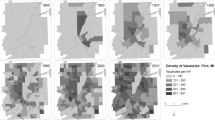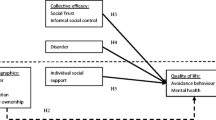Abstract
This study investigates how neighborhood deterioration is associated with stress and depressive symptoms and the mediating effects of perceived neighborhood social conditions. Data come from a community survey of 801 respondents geocoded and linked to a systematic on-site assessment of the physical characteristics of nearly all residential and commercial structures around respondents’ homes. Structural equation models controlling for demographic effects indicate that the association between neighborhood deterioration and well-being appear to be mediated through social contact, social capital, and perceptions of crime, but not through neighborhood satisfaction. Specifically, residential deterioration was mediated by social contact, then, social capital and fear of crime. Commercial deterioration, on the other hand, was mediated only through fear of crime. Additionally, data indicate that the functional definition of a “neighborhood” depends on the characteristics measured. These findings suggest that upstream interventions designed to improve neighborhood conditions as well as proximal interventions focused on social relationships, may promote well-being.


Similar content being viewed by others
References
Aneshensel, C. S., & Sucoff, C. A. (1996). The neighborhood context of adolescent mental health. Journal of Health and Social Behavior, 37, 293–310.
Austin, D. M., Furr, L. A., & Spine, M. (2002). The Effects of Neighborhood Conditions on Perceptions of Safety. Journal of Criminal Justice, 30, 417–427.
Austin, D. M., Woolever, C., & Baba, Y. (1994). Crime and safety-related concerns in a small community. American Journal of Criminal Justice, 19, 79–97.
Baba, Y., & Austin, D. M. (1989). Neighborhood environmental satisfaction, victimization and social participation as determinants of perceived neighborhood safety. Environment and Behavior, 21, 763–780.
Baum, A., Singer, J. E., & Baum, C. S. (1981). Stress and the environment. Journal of Social Issues, 37, 4–35.
Box, S., Hale, C., & Andrews, G., (1988). Explaining fear of crime. British Journal of Criminology, 28, 340–356.
Bronzaft, A. L., & McCarthy, D. P. (1975). The effect of elevated train noise on reading ability. Environment and Behavior, 7, 517–528.
Browning, C. R., & Cagney, K. A. (2002). Neighborhood structural disadvantage, collective efficacy, and self-rate physical health in an urban setting. Journal of Health and Social Behavior, 43, 383–400.
Cohen, D., Spear, S., Scribner, R., Kissinger, P., Mason, K., & Wildgen, J. (2000). “Broken windows” and the risk of gonorrhea. American Journal of Public Health, 90, 230–236.
Cohen, S., Kamarck, T., & Mermelstein, R. (1983). A global measure of perceived stress. Journal of Health and Social Behavior, 24, 385–396.
Coleman, J. S. (1990). The foundations of social theory. Cambridge: Harvard University Press.
Damon, W. (1977). The social world of the child. San Francisco: Jossey-Bass.
Derogatis, L. R. (2001). Brief symptom inventory-18 (bsi-18) administration, scoring, and procedures manual. Minneapolis: NCS Pearson.
Ellen, J.M., Jennings, J.M., Meyers, T., Chung, S., & Taylor, R. (2004). Perceived social cohesion and prevalence of sexually transmitted diseases. Sexually Transmitted Diseases, 31, 117–122.
Faris, R., & Dunham, H. W. (1939). Mental disorders in urban areas. Chicago: University of Chicago Press.
Farrell, S. J., Aubry, T., & Coulombe, T. A. (2004). Neighborhoods and neighbors: Do they contribute to personal well-being. Journal of Community Psychology, 32, 9–25.
Furstenburg, F. F. (1993). How families manage risk and opportunity in dangerous neighborhoods. In W. J. Wilson (Ed.), Sociology and the public agenda (pp. 231–258). Newbury Park: Sage.
Garbarino, J., & Kostelny, K. (1992). Child maltreatment as a community problem. Child Abuse and Neglect, 16, 455–464.
Gee, G., & Payne-Sturges, D. (2004). Environmental health disparities: A framework integrating psychosocial and environmental concepts. Environmental Health Perspectives, 112, 1645–1653.
Huckfeldt, R. R. (1983). Social contexts, social networks and urban neighborhoods: Environmental constraints on friendship choice. American Journal of Sociology, 89, 652–669.
Hunter, A. (1974). Symbolic communities. Chicago: University of Chicago Press.
Institute of Medicine Transportation Research Board (2005). Does the built environment influence physical activity? examining the evidence. TRB special report 282. Washington: Author.
Kawachi, I., Kennedy, B. P., & Wilkinson, R.G. (1999). Crime: Social disorganization and relative deprivation. Social Science & Medicine, 48, 719–731.
Latkin, C. A., Williams, C. T., Wang, J., & curry, A. D. (2005). Neighborhood social disorder as a determinant of drug injection behaviors: A structural equation modeling approach. Health Psychology, 24, 96-100.
Lazarus, R. S. (1999). Stress and emotion: A new synthesis. New York: Springer.
Lazarus, R. S., & Folkman, S. (1984). Stress, appraisal and coping. New York: Springer.
Lee, R.E., Cubbin C. (2002). Neighborhood context and youth cardiovascular health behaviors. American Journal of Public Health 92, 428–436.
Leventhal, T., & Brooks-Gunn, J. (2003). Children and youth in neighborhood contexts. Current Directions in Psychological Science, 12, 27–31.
Lewis, D.A., & Maxfield, M.G. (1980). Fear in the neighborhoods: An investigation of the impact of crime. Journal of Research and Crime and Delinquency, 17, 160–189.
Park, R. E., & Burgess, E. W. (1925). The city. Chicago: University of Chicago Press.
Pachter, L.M., Auinger, P, Palmer R, & Weitzman, M. (2006). Do parenting and the home environment, maternal depression, neighborhood, and chronic poverty affect child behavioral problems differently in different racial-ethnic groups? Pediatrics, 117, 1329–1338.
Perkins, D. G., & Taylor, R. B. (1996). Ecological assessments of community disorder: Their relationship to fear of crime and theoretical implications. American Journal of Community Psychology, 24, 63–107.
Prezza, M., Amici, M., Roberti, T., & Tedeschi, G. (2001). Sense of community referred to the whole town: Its relations with neighboring, loneliness, life satisfaction and area of residence. Journal of Community Psychology, 29, 29–52.
Putnam, R. D. (1993). Making democracy work: Civic traditions in modern italy. Princeton: Princeton University Press.
Raudenbush, S. W., & Bryk, A. S. (2002). Hierarchical linear models: Applications and data analysis methods. Thousand Oaks: Sage Publications.
Ross, C. E. (2000). Neighborhood disadvantage and adult depression. Journal of Health and Social Behavior, 41, 177–187.
Ross, C. E., & Mirowsky, J. (1999). Disorder and decay: The concept and measurement of perceived neighborhood disorder. Urban Affairs Review, 34, 412–432.
Ross, C. E., & Mirowsky, J. (2001). Neighborhood disadvantage, disorder, and health. Journal of Health and Social Behavior, 42, 258–276.
Ross, C.E., & Jang, S.J. (2000). Neighborhood disorder, fear, and mistrust: The buffering role of social ties with neighbors. American Journal of Community Psychology, 28, 401–420.
Saegert, S., & Winkel, G. (2004). Crime, social capital, and community participation. American Journal of Community Psychology, 34, 219–233.
Sampson, R. J. (1995). The community. In J. Q. Wilson & J. Petersilia (Eds.), Crime (pp. 193–216). San Francisco: Institute for Contemporary Studies.
Sampson, R. J., Morenoff, J. D., & Earls, F. (1999). Beyond social capital: Spatial dynamics of collective efficacy for children. American Sociological Review, 64, 633–660.
Sampson, R. J., Raudenbush, S. W., Earls, F. (1997). Neighborhoods and violent crime: A multilevel study of collective efficacy. Science, 227, 918–923.
Sandler, I. N., Wolchik, S. A., MacKinnon, D., Ayers, T. S., & Roosa, M. W. (1997). Developing linkages between theory and intervention in stress, coping processes. In S. A. Wolchik & I. N Sandler (Eds.), Handbook of children’s coping: Linking theory and intervention (pp. 3–41). New York: Plenum.
Savi, R. M., Lara, D. R., Ghisolfi, E. S., Portela, L. V., Dias, R. D., & Souza, D. O. (2003). Neuropsychiatric evaluation in subjects chronically exposed to organophosphate pesticides. Toxicological Sciences, 72, 267–271.
Seneviratne, P. N. (1985). Acceptable walking distances in central areas. Journal of Transportation Engineering, 3, 365–376.
Skogan, W. (1991). Disorder and decline. New York: Free Press.
Skogan, W. G., & Maxfield, M. G. (1981). Coping with crime. Newbury Park: Sage.
Smith, S. K., Steadman, G. W., Minton, T. D., & Townsend, M. (1999). Criminal victimization and perceptions of community safety in 12 cities, 1998. Bureau of Justice Statistics and Office of Community Oriented Policing Services, US Department of Justice. Available at http://www.ojp.usdoj.gov/bjs/pub/pdf/cvpcs98.pdf, accessed on April 20, 2005.
Stallones, L., & Breseler C. (2002). Pesticide poisoning and depressive symptoms among farm residents. Annals of Epidemiology, 12, 389–394.
Taylor, R. B. (2001). Breaking away from broken windows: Evidence from Baltimore neighborhoods and the nationwide fight against crime, grime, fear, and decline. Boulder: Westview Press.
Taylor, R. B., Shumaker, S. A., & Gottfredson, S. D. (1985). Neighborhood-level links between physical features and local sentiments: Deterioration, fear of crime, and confidence. Journal of Architectural Planning and Research, 2, 261–275.
U.S. Census. (2001a). Census 2000 Summary File 1. Washington, Author. Available at: http://factfinder.census.gov/, accessed on April 20, 2005.
U.S. Census. (2001b). Census 2000 Summary File 3. Washington, Author. Available at: http://factfinder.census.gov/, accessed on April 20, 2005.
Wandersman, A., Andrews, A. B., Riddle, D., & Fawcett, C. (1983). Environmental psychology and prevention. In R. D. Felner, L. A. Jason, J. N. Moritsugu, & S. S. Farber (Eds.), Preventive psychology: Theory, research and practice (pp. 104–127). New York: Pergamon Press.
Wandersman, A., & Nation, M. (1998). Psychological contributions to understanding toxicity, resilience, and interventions. American Psychologist, 53, 647–656.
Weenig, M. W. H., Schmidt, T., & Midden, C. J. H. (1990). Social dimensions of neighborhoods and the effectiveness of information programs. Environment and Behavior, 22, 27–54.
White, M., Kasl, S. V., Zahner, G. E. P., & Will, J. C. (1987). Perceived crime in the neighborhood and mental health of women and children. Environment and Behavior, 19, 588–613.
Wiesenfeld, E. (1996). The concept of “we”: A community social psychology myth? Journal of Community Psychology, 24, 337–345.
Zenk, S. N., Schulz, A. J., Israel, B. A., James, S. A., Bao, S., & Wilson, M. L. (2005). Neighborhood racial composition, neighborhood poverty, and the spatial accessibility of supermarkets in metropolitan Detroit. American Journal of Public Health, 95, 660–667.
Acknowledgements
The Speak to Your Health! Community Survey was supported by the Prevention Research Center of Michigan (Centers for Disease Control and Prevention Grant No. U48/CCU515775) and the Genesee County Health Department. We would like to thank Survey Committee members for their assistance, and all those who participated in the project.
Author information
Authors and Affiliations
Corresponding author
Additional information
At the time of this study, Dr. Gee was at the University of Michigan.
Rights and permissions
About this article
Cite this article
Kruger, D.J., Reischl, T.M. & Gee, G.C. Neighborhood Social Conditions Mediate the Association Between Physical Deterioration and Mental Health. Am J Community Psychol 40, 261–271 (2007). https://doi.org/10.1007/s10464-007-9139-7
Published:
Issue Date:
DOI: https://doi.org/10.1007/s10464-007-9139-7




